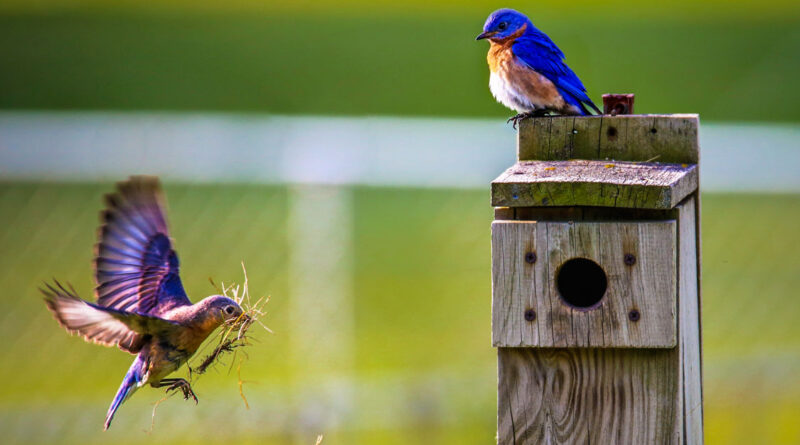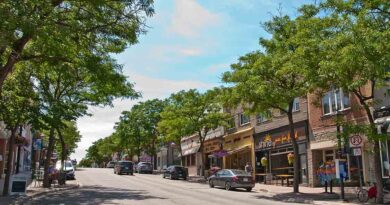Nesting Season Tips
By Mike Jones – Special to SUNonline/Orillia
Nesting season is in full swing in Orillia. Many species such as owls, starlings, ducks and geese have already fledged and have left the nest, while robins, grackles and red-winged blackbirds follow close behind.
Warblers have pretty much stopped singing in the early mornings, signalling that their courtship songs have been successful in attracting mates. Their focus now shifts to finding a suitable nesting site and materials. American goldfinches are late nesters. It was once thought that they postponed nesting until the thistles bloomed in August so they could use the soft thistledown to line their nests. However, as they are seed eaters, it’s more likely that August corresponds to a time when plenty of the seeds necessary for feeding their young are available.
Birds are very careful in selecting locations and constructing nests. Over the past few weeks, your garden has been gone over with a fine-tooth comb, as nesting birds search out the perfect nest linings.
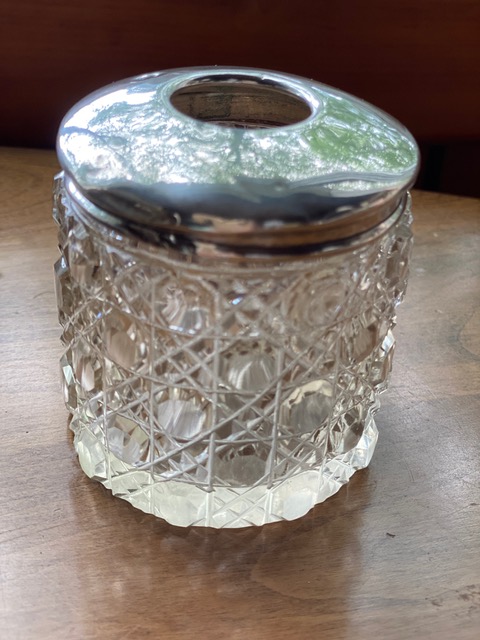
After you groom your dog or cat leave the hair or fur in the garden during nesting time and it will not be there for long. The same is true for human hair – although there was a time when this was not encouraged. Your great grandmother may have carefully placed her hair combings in a Victorian Hair Tidy, a little crystal jar. The superstition at the time was, if the combings were used for bird’s nests, granny would get a headache, so they were carefully collected and burned.
Birds can surprise us with their choice of nesting materials. Once we bought wire hanging planters with an inner basket of coconut fibre and soon discovered that the fibre lining of our planters had taken on a dishevelled, untidy appearance. We were mystified as to how this happened, but eventually caught the culprits in the act – Northern orioles.
Orioles are the ultimate structural engineers of the avian world. Their gourd-shaped nests hang from the highest branches; branches so slim that they will not bear the weight of would-be predators. Our baskets had provided the perfect nesting material – light, with enough tensile strength to withstand summer gales and the weight of mother and fledglings. You may well have an Oriole’s nest hidden among the dense foliage of a tree in your garden. Look up in the fall when the leaves have fallen, and you might just be able to see one.
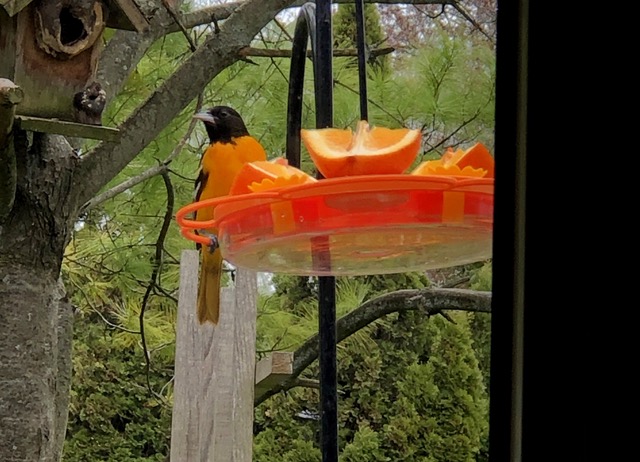
Location is everything with nests. The quieter, the more hidden, the better. In the accompanying picture of the Oriole, there is a nesting box located in the upper left. No self-respecting bird will nest in a box so close to an active feeding station. However, in areas of low traffic, dense tree or shrub foliage, loosely trimmed cedar hedges, even in piles of brushwood the nests will be there. In most cases you will never know where they are, because nesting birds are so surreptitious in entering and leaving their nests.
Robins, Eastern phoebes and wrens are a bit more confident and will nest in closer proximity to humans, on a window ledge or even in, or on top of, a mailbox if there is not much traffic. Robins will use a nesting platform located on a north-facing wall, not too high above the ground and not near a tree or place where squirrels can get to it.
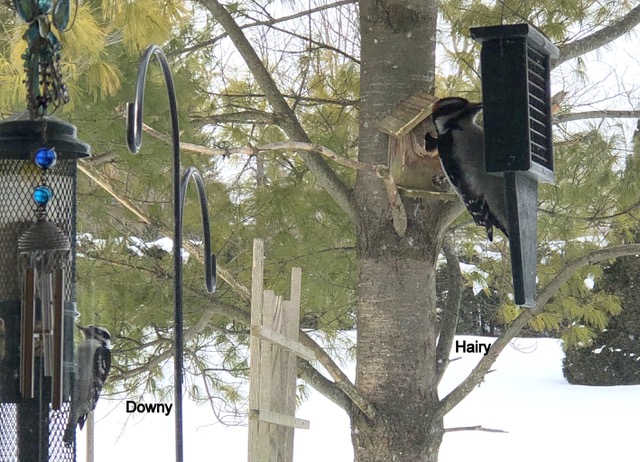
Let’s talk about cavity nesters and how we might help them find suitable nesting spots in our gardens. Orillia is blessed by the presence of every woodpecker to be found in Ontario: downy, hairy, yellow-bellied sapsucker, red-bellied, Northern flicker, three-toed, red-headed, pileated and even the occasional black-backed woodpecker. Also competing for a good cavity to nest in are chickadees, nuthatches, tree swallows, wrens, great crested flycatchers, some owls, wood ducks, and several invasive species such as starlings and house sparrows.
The best and most natural way to help cavity nesters is to be very judicious about trees we cut down on our properties. When you do have to cut down a tree, if part of the trunk can be safely left, it can provide cavities for nesting species and a food source in the form of insects as it slowly decays away.
Nesting boxes assist cavity nesters with their house hunting. A good nesting box should replicate a hole in a tree as much as possible. It should not be made of finished wood, nor be stained or painted. Cavity nesters have claws developed to cling to the bark of trees, so they do not require a perch or landing platform below the entrance hole. On the other hand, predatory, nest-robbing birds such as blue jays, grackles and crows do not have clinging claws and just love having a perch from which to reach in and extract eggs or nestlings.
The eastern strain of purple martins seem to have lost their ability to nest anywhere but in an artificial nesting boxes provided by humans. To add to their woes, being migratory, they often lose out to year-round resident starlings who often commandeer their nesting sites by the time the Martins arrive back from the South.
Nesting boxes can be made easily and economically by anyone with a rudimentary knowledge of carpentry. Information about the size of box and entrance hole targeted to various species of bird can be found on line at sites such as the Canadian Wildlife Federation, or Sialis. We’ll talk more specifically about nesting boxes in a future article.
By now, perhaps you think helping the birds out is all very well, but you may also be thinking, “What? Don’t mow my lawn? Don’t use pesticides or fertilize it? Leave dead trees standing? Allow my garden to become untidier? No way! What would our neighbours say?”
Unless you have a larger property or garden, I totally get it, and do not expect anyone to convert their garden into the equivalent of Scout Valley or Grant’s Woods. However, every good garden, however formal, however small, has a naturalized place. Perhaps its tucked out of sight behind an out-building, or in a working area of the garden by a composter, or a raised vegetable bed. Formality or tidiness is not an issue here. This is your private, peaceful space where you can putter around and be alone with your thoughts, perhaps even an area of spiritual regeneration. Could this become the favourite part of your garden? Chances are it already is the most bird-friendly part of your garden.
(Photos Supplied)

